To blend oil fragrances, you'll need essential oils, glass bottles, droppers, and a fragrance journal. Follow the 30/50/20 rule: combine 30% top notes (like citrus), 50% middle notes (herbs and spices), and 20% base notes (woody scents) for balanced blends. Start with small batches of 5-20 drops total, and let your creations mature for 48 hours. Store your blends in dark glass bottles and document each combination. This starter guide opens the door to countless aromatic possibilities.
Understanding Essential Oil Properties

When you begin exploring essential oils, understanding their fundamental properties becomes crucial for successful blending. Each essential oil possesses a unique chemical makeup that determines its aroma and therapeutic benefits, from promoting relaxation to boosting energy levels.
To create harmonious essential oil blends, you'll need to understand the five main fragrance clusters: Citrus, Floral, Herbal, Spicy, and Woody. These categories work together following the 30/50/20 rule, where fragrance notes are balanced with 30% top note oils, 50% middle notes, and 20% base notes.
When blending essential oils, remember to let your creation rest for at least 48 hours. This waiting period allows the scents to meld together, giving you a true representation of how your final blend will smell.
Basic Blending Equipment and Tools
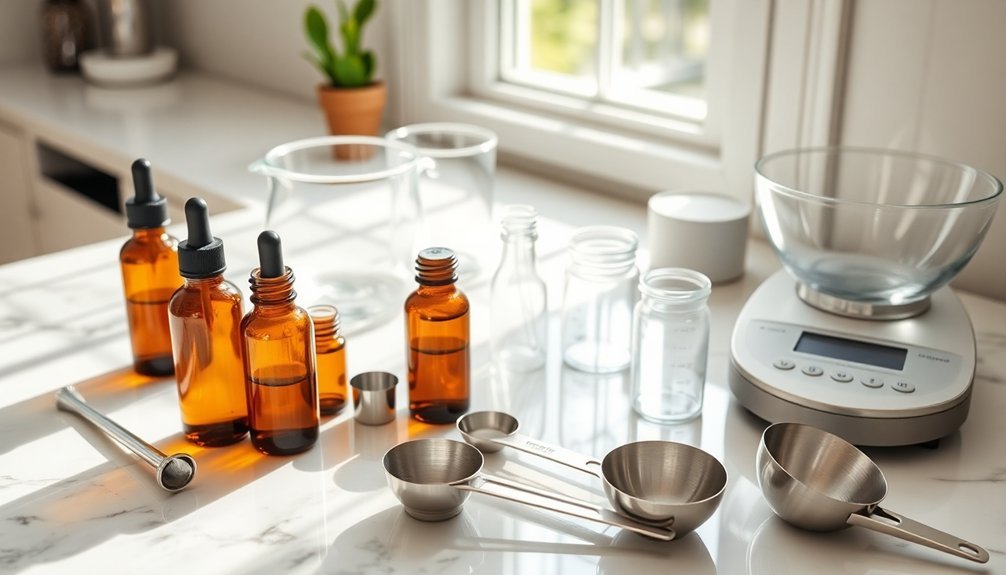
Your essential blending kit starts with protective gloves, droppers, and small glass bottles to safely handle and store your fragrance oils.
You'll need precision tools like pipettes and blotters to accurately measure and test your blends as they develop.
Keep track of your blending experiments in a fragrance journal, documenting exact measurements and observations to replicate your successful combinations.
Essential Blending Kit Components
Five essential components form the foundation of any oil blending kit, enabling you to create custom fragrances safely and precisely.
When you're starting your essential oil blending journey, you'll need a diverse selection of oils covering top, middle, and base notes for balanced fragrance creation. Your blending tips should include wearing protective gloves to prevent skin reactions during the process.
For accurate fragrance oil blending, invest in precision tools like droppers and pipettes to measure your oils perfectly. Store your creations in small glass bottles, ranging from 1/24 to 1/4 oz., which prevent unwanted chemical reactions.
Finally, keep perfume blotters or cotton balls handy – they're invaluable for testing your blends and observing how the scents evolve during evaporation.
Safe Measurement Tools Required
Safety and precision go hand in hand when blending fragrance oils, requiring specific tools for accurate measurements and protection.
You'll need droppers or pipettes for precise measurement and controlled dispensing of each essential oil into your blends.
Store your fragrance creations in small glass bottles, ranging from 1/24 oz. to 1/4 oz., which prevent unwanted reactions with your blended oils.
Don't forget to wear protective gloves when handling undiluted essential oils to safeguard your skin during the blending process.
For testing your fragrance combinations, use perfume blotters or cotton balls to observe how the aromas develop.
Keep track of your blending success by maintaining a detailed fragrance journal, where you'll record ingredients, measurements, and results for future reference and refinement.
Fragrance Notes and Their Roles
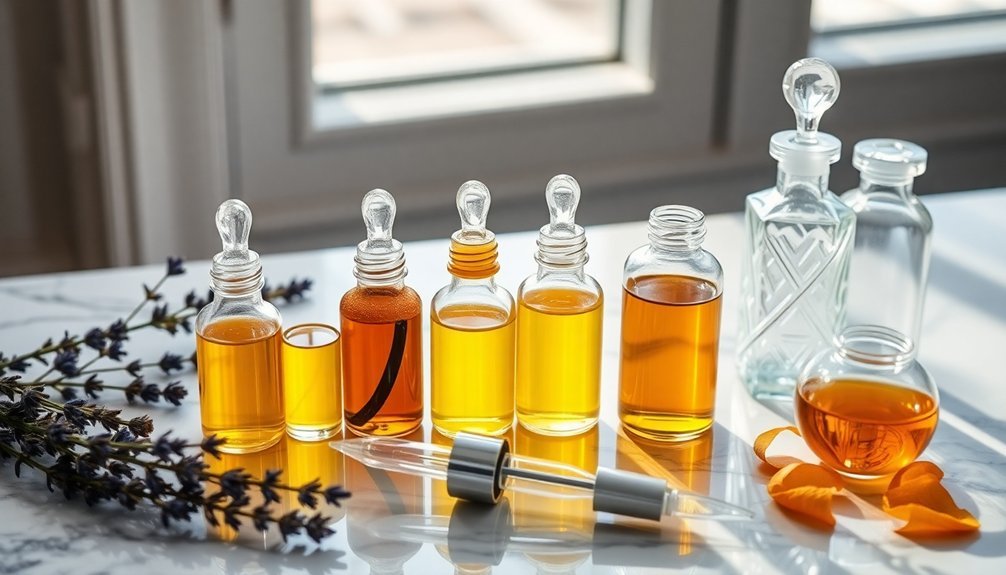
When creating oil fragrances, understanding the three primary types of notes – top, middle, and base – is vital for achieving a well-balanced blend.
The initial impact comes from top notes, which make up 30% of your blend and typically feature light, invigorating scents like citrus or florals. As these fade, middle notes emerge, comprising 50% of your fragrance. They're your blend's heart, often incorporating herbs and spices to create harmony between the other elements.
Top notes are your fragrance's first impression, while middle notes create the harmonious heart that bridges the entire aromatic experience.
Base notes, while only 20% of the composition, are fundamental for fragrance blending as they provide lasting power and depth through rich aromas like woods and resins.
You'll need to take into account how these three layers interact, as they'll evolve together over time to create your signature scent's complete journey from first spritz to final dry-down.
Safe Mixing Ratios and Techniques
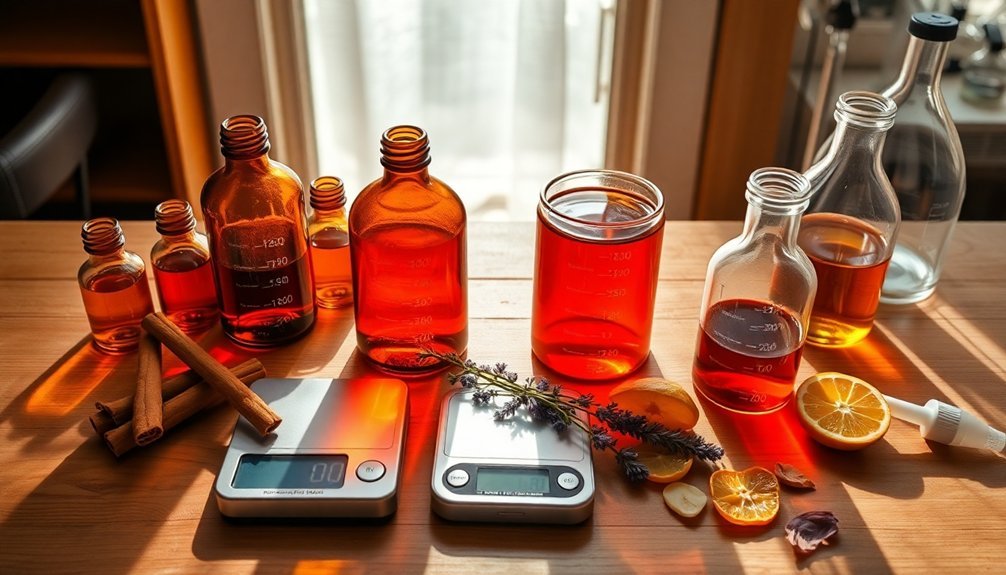
You'll want to start with the proven 30-50-20 ratio of top, middle, and base notes to create a well-balanced fragrance blend.
Begin your mixing process with small increments of about 5 drops, never exceeding 20 drops total, and test your creation on blotter strips to evaluate how the scent develops over time.
Keep meticulous notes of your blending ratios and combinations in a fragrance journal, ensuring you can replicate successful blends in the future.
Basic Blending Ratio Rules
Creating successful fragrance blends starts with understanding fundamental mixing ratios. You'll want to follow the 30-50-20 rule: 30% top notes, 50% middle note oils, and 20% base notes for balanced scent combinations. When blending scents, start with small 5-drop increments and don't exceed 20 drops total.
| Note Type | Percentage | Drops (20 Total) |
|---|---|---|
| Top | 30% | 6 drops |
| Middle | 50% | 10 drops |
| Base | 20% | 4 drops |
Let your blend mature for several days to achieve the best results. Focus on oils within similar scent categories to create harmonious combinations. Keep detailed records of your blends, including ratios and impressions, in a fragrance journal – you'll thank yourself later when recreating successful formulas.
Drop-by-Drop Safety Guidelines
Safety comes first in fragrance blending, building upon the fundamental ratio rules we've discussed.
When you start your blend, work with small amounts – no more than 5 drops at a time, keeping your total mixture under 20 drops. You'll want to maintain the proven ratio of 30% top notes, 50% middle notes, and 20% base notes for a balanced fragrance.
Always protect yourself by wearing gloves and goggles while handling essential oils to prevent skin reactions and respiratory issues.
Don't forget to document every drop you use in your blend – this record-keeping guarantees you can recreate successful combinations later.
After mixing, let your creation rest for several days. This waiting period allows the chemical components to interact properly, resulting in a more refined final scent.
Essential Testing Methods
To master the art of fragrance blending, precise testing methods guarantee consistent and appealing results. When testing essential oil combinations, follow the 30/50/20 rule: 30% top notes, 50% middle notes, and 20% base notes for a well-balanced blend.
Start your testing process with small batches, using no more than 20 drops total. Place your scents on blotter strips or cotton balls to observe how they evolve during evaporation.
You'll want to let your blend mature for at least 48 hours before making final assessments, as chemical interactions can greatly alter the fragrance profile.
Keep detailed records of your blending experiments in a fragrance journal. Document the oils used, their ratios, and your impressions – this will help you recreate successful combinations and refine your technique over time.
Creating Harmonious Scent Combinations
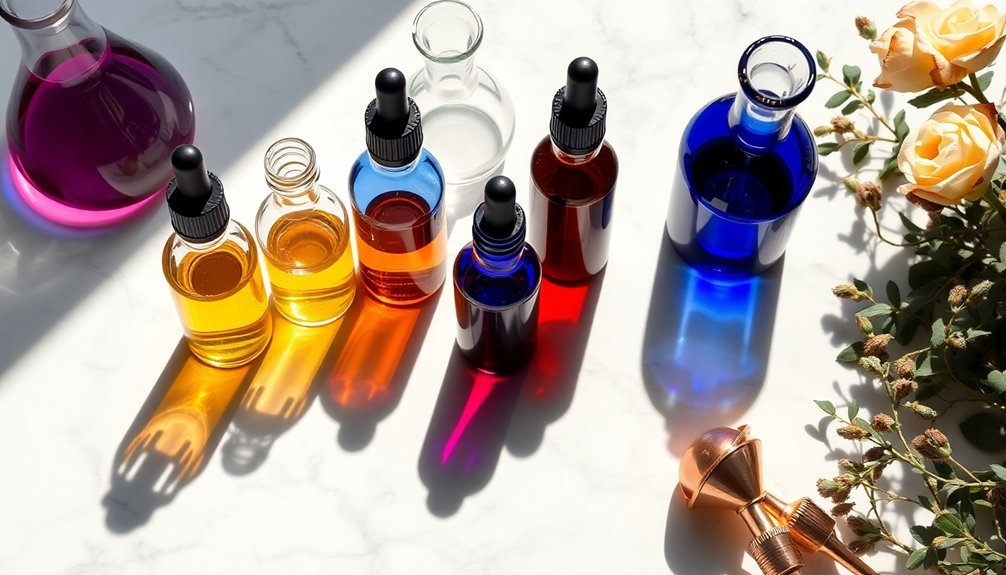
For anyone venturing into fragrance blending, understanding the art of harmonious scent combinations starts with mastering the three distinct fragrance notes: top, middle, and base.
You'll want to follow the 30-50-20 ratio when creating your unique blends, which means 30% top notes, 50% middle notes, and 20% base notes.
To create successful fragrance blends, stick to oils within similar scent categories, as they naturally complement each other.
Similar scent families blend harmoniously, making them the perfect starting point for creating captivating fragrance combinations.
Start your experimentation with small amounts—just 5 drops at a time—and keep detailed notes of your combinations.
Once you've mixed your blends, let them rest for several days to allow the chemicals to interact fully.
Use perfume blotters to test how your scent evolves over time, making adjustments until you achieve your desired fragrance profile.
Testing and Documenting Your Blends
Testing your blended oils requires patience and systematic documentation to achieve consistent, high-quality results. Start by placing a few drops of your blend on fragrance strips or cotton balls, then evaluate how the scent evolves over time.
You'll want to note the distinct stages of evaporation, from top notes to base notes.
Keep a detailed fragrance journal to document every aspect of your blend testing. Record the specific oils you've used, exact drop counts, and your impressions of each creation.
Don't rush to judge your blend immediately – let it rest for several days to allow the oils to interact chemically. Make sure to track any adjustments you make to the ratios during the testing process.
This methodical approach will help you refine your blending skills and create better fragrances.
Storing and Preserving Oil Fragrances
After mastering the art of blending and testing fragrances, proper storage becomes the next key focus for maintaining your creations.
You'll want to store your fragrance oils in dark, amber glass bottles to shield them from light damage that can alter their scent profiles and affect oil dilution quality.
Keep your bottles in a cool, dry environment and make certain they're tightly sealed to prevent unwanted evaporation.
Fragrance oils require diligent storage practices – keep bottles sealed tight in cool spaces to maintain their aromatic integrity.
For ideal longevity, consider refrigerating particularly volatile fragrances.
Don't forget to label each bottle with essential information like the fragrance name, purchase date, and blend notes – this will help you track your creations and maintain consistency in future blends.
Frequently Asked Questions
What Is the Rule for Blending Essential Oils?
You'll want to follow the 30/50/20 rule: use 30% top notes for light scents, 50% middle notes for balance, and 20% base notes for depth. Let your blend sit for 48 hours before testing.
What Is the 30/50/20 Rule for Perfume?
You'll create balanced perfumes by following the 30/50/20 rule: use 30% top notes for initial impact, 50% middle notes for the heart of your fragrance, and 20% base notes for lasting depth.
What Fragrance Oil Blends Well Together?
You'll find citrus oils blend well with florals like lavender and jasmine. Try mixing sandalwood with vanilla for depth, or combine woody cedarwood with spicy notes for a rich, complex fragrance.
How to Blend Essential Oil Scents?
You'll want to follow the 30/50/20 rule: mix 30% top notes (citrus), 50% middle notes (floral), and 20% base notes (woody). Start with 10 drops total, use droppers, and let rest for 48 hours.
In Summary
Now that you've learned the fundamentals of blending essential oils, you're ready to start creating your own signature scents. Don't be afraid to experiment with different combinations while following the safety guidelines you've learned. Remember to document your successful blends and keep your oils properly stored. With practice and patience, you'll develop an intuitive understanding of how fragrances work together.
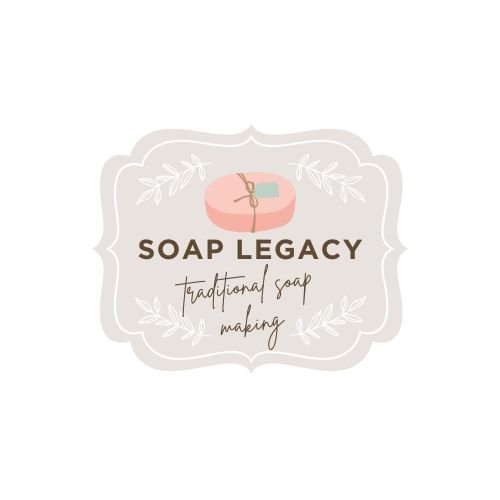

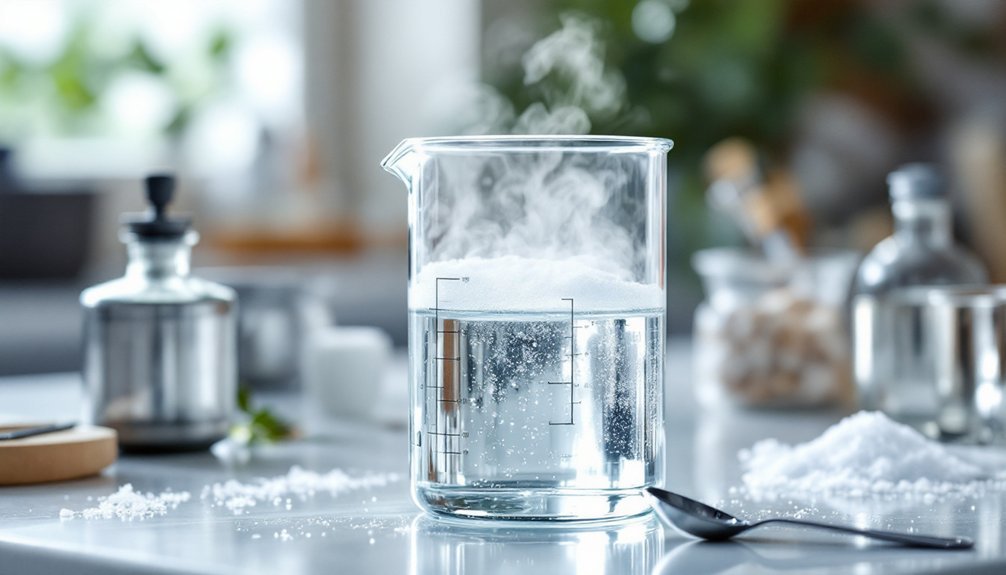
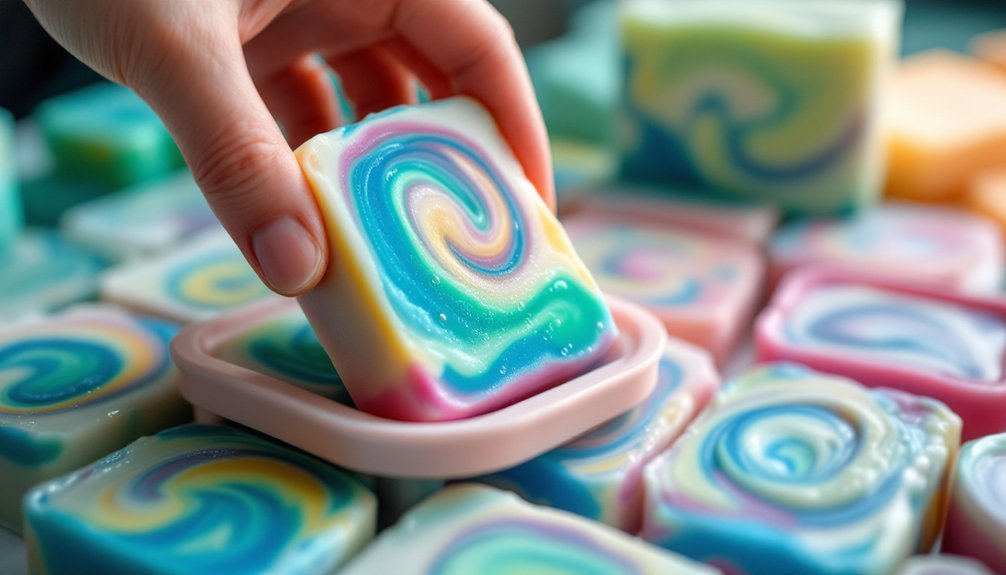

Leave a Reply